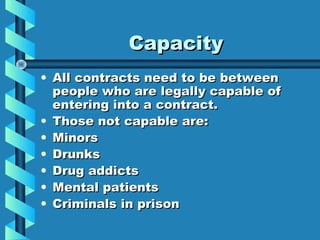Capacity
•Télécharger en tant que PPT, PDF•
0 j'aime•221 vues
this powerpoint talks about capacity
Signaler
Partager
Signaler
Partager

Contenu connexe
En vedette (11)
bill of exchange, dishonour of bill and noting&protesting

bill of exchange, dishonour of bill and noting&protesting
Capacity
- 1. Capacity • All contracts need to be between people who are legally capable of entering into a contract. • Those not capable are: • Minors • Drunks • Drug addicts • Mental patients • Criminals in prison
- 2. Capacity • There are exceptions to the concept of capacity in relation to minors • Necessary • CASE: Nash v Inman • Benefit • CASE: Roberts v Gray
- 3. Vitiating factors • There are some factors which make a contract not legally binding these factors are known as vitiating factors and are: • Misrepresentation • Duress and • Influence • We will only need to look at misrep